13 Factors That Influence Your Food Perception
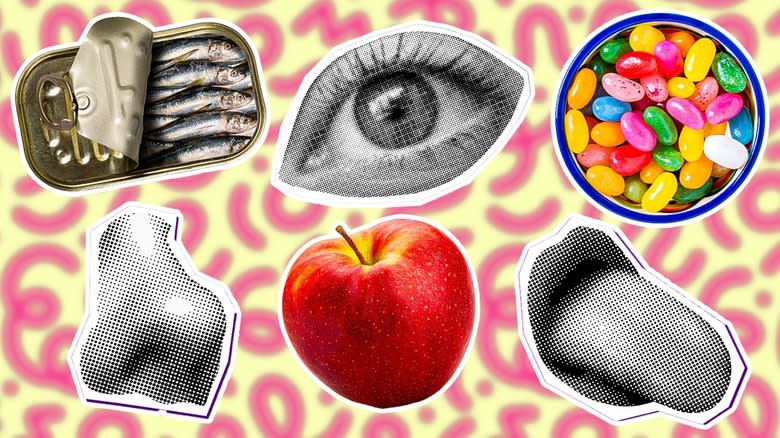
In the world of modern gastronomy, flavor is king. We're always in pursuit of creating, perfecting, and exploring flavors, going outside the realm of basic tastes. But what most people don't realize is that taste is affected by more than cooking methods or creative combinations. This is where gastrophysics comes into play. Standing at the intersection of food, science, and human perception, it delves into the multisensory experience of eating, examining how extrinsic factors such as aroma, texture, color, and presentation influence our enjoyment and appreciation of food. More importantly, it investigates our perception of flavor, demonstrating how the same food can taste different in unique circumstances.
When we eat, all our senses are engaged. They fuel our expectations and provide us with reliable information about what we're consuming. However, they can easily be manipulated, though that's not necessarily a bad thing. Whether you're in the food business, looking for ways to create immersive and engaging gastronomic experiences for your patrons, or an ambitious home cook trying to impress dinner guests, this is your introduction to gastrophysics. This interdisciplinary science can help you tantalize the senses, play around with people's expectations, and influence their perception of flavor. It sounds like magic, but it's science!
Read more: Styles Of Regional BBQ In The US
Expectations

You don't need to bite into a lemon wedge or lick salt off a rim to imagine their flavors -- your experiences with these foods will readily remind you. But there are more factors influencing your expectations and, consequently, your flavor perception and hedonic rating (i.e., how much you like it). These include color, smell, price, and description.
Tint white wine red and offer it to someone, asking to describe its flavor. If they're anything like the subjects of a 2001 study published in Brain and Language, they'll likely be fooled into thinking it actually smells and tastes like red wine. If you tell them the wine was expensive, too, they will like it even more. Present them with a pink sorbet, and they will expect it to be sweet, but if it's actually savory — like the smoked salmon ice cream in Heston Blumenthal's famous experiment — it creates a discrepancy. Participants who didn't know what the dish was and had to rely on the color to inform their expectations did not like it, thinking it was too salty. Those told they were about to eat a frozen savory mousse enjoyed it more and thought the flavor was just right. The dish hadn't changed, but an appropriate description set up correct expectations and altered its flavor perception.
Language

Open any online recipe collection, and you'll notice the heavy use of certain food-related descriptors in the titles. Some will convey the dish's texture (often using the evocative trio of "crispy," "creamy," and "crunchy"). Others will emphasize the key ingredients and cooking methods, signal the overall flavor, attribute dishes to seasons or places of origin, or simply create a certain vibe ("refreshing," "decadent," and "organic"). You'll notice the same tendencies in some restaurant menus. Ask yourself: Would you be more excited to order a pistachio ice cream or an International Slow Food Institute-certified Sicilian pistachio ice cream? Exactly. These epithets are there to create expectations and influence your hedonic ratings.
Language on labels can change your perception of flavor, too. Research shows that if the food is labeled with something you're negatively biased against (e.g., "soy protein," "nonalcoholic," or "consumer complaint"), it is perceived as worse than it actually is. Conversely, if the label creates an association with something positive, such as healthfulness or elite tastemakers (e.g., Michelin-starred chefs or royalty), we rate the taste higher. So, if you're in the business of feeding people, remember that being mindful of the language you use to describe your dishes or products matters almost as much as the quality and flavor itself.
Lighting

Most of us consider lighting in connection to food only when we're trying to snap a shareable picture of it. But its powers go beyond making food look photogenic. Ambient lighting can influence what we choose to eat, what it tastes like to us, and how much we indulge ourselves, not to mention whether or not we enjoy it. Its color and intensity play an important role here, so the next time you drink coffee at a fluorescent-lit gas station or have an intimate candlelit dinner, pay attention to how that affects your senses.
The research that has been done on the topic so far demonstrates that the brighter the light, the less we eat. Similarly, darker environments may push us toward unhealthier food choices and make us forego portion control. Dim light has also been shown to improve our taste sensitivity-- but only to basic, one-note tastes. So, if you want to experience the full symphony of flavors of a complex dish without overeating, turn the lights up. Come wine and dessert time, opt for red-tinted lights, as they've been shown to increase our perception of sweetness (since the color itself is often associated with it, but more on that later).
Sounds

Have you ever heard of sonic seasoning? It's the auditory ingredient in the multisensory dish of dining. Our perception of flavor is enhanced or attenuated when sound is introduced. Compare eating guacamole with a spoon or with a nacho chip -- which would you prefer? The latter adds a crunchy sonic element to an otherwise silent food, making it more exciting. And if that nacho chip is stale, just listen to a track of someone crunching chips loudly to boost your perception of its freshness. Alternatively, as our brains have trouble differentiating between the product and the package, eating it out of the noisy plastic can add to the enjoyment.
Moreover, altering noise can change the way our palates taste food. If you're in an environment where ambient noise is over 85 decibels (e.g., a busy, loud restaurant or an airplane cabin), food won't taste as sweet or as salty as it would in a quieter place. Interestingly, umami isn't affected by this. More importantly, what we listen to and how much we like it alters our perception. For instance, we associate certain musical patterns with different flavors -- high-pitched sounds with sweetness and sourness and low-pitched with bitterness and umami. Similarly, we match staccato with saltiness and fast, high-pitched music with a distorted timbre with spiciness.
Smells
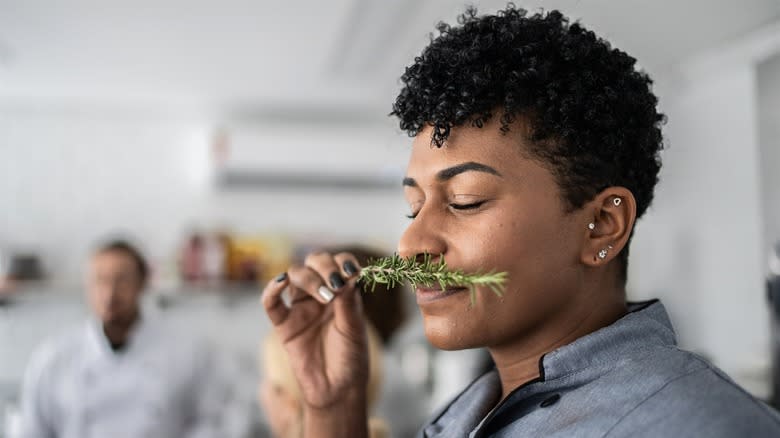
The distinction between taste and flavor lies in the aroma — our tongue detects the basic tastes, but our nose creates the full flavor picture. We inhale the scent of food before we get to taste it, performing orthonasal olfaction. This initial sniff primes our flavor expectations and perceptions. But that's only half of it. As we bite, chew, and swallow, we engage in retronasal olfaction, or the process of pushing the aromatic compounds back up to the nasal cavity. Sometimes, these two processes don't add up: "Bad-smelling" foods like stinky tofu, aged cheese, or kimchi actually have a wonderful flavor when you taste them. Moral: Don't knock it off (after you sniffed it) until you've tried it (engaged in retronasal olfaction).
Restaurateurs and food companies love to play with our senses. Modernist chefs often create multisensory experiences by using extrinsic aromas, such as moss, eucalyptus, or burnt oak leaves. These don't just create a certain atmosphere, triggering feelings and memories, but make you "taste" those added aromas with your nose when you eat. As we associate certain smells with specific tastes, this can be used to trick our impression of flavor. For example, "fatty smells" can be added to low-fat products, and the smell of ham can change your perception of saltiness in low-sodium products.
Colors
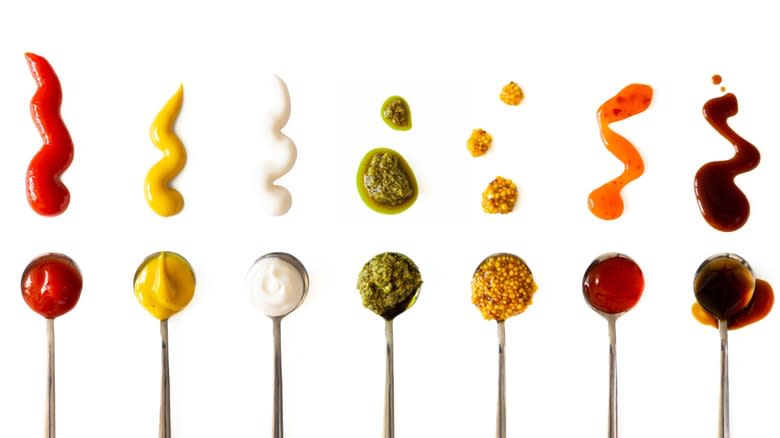
Imagine you were presented with four edible spheres: red, white, green, and brown. Which would you assume was bitter, sour, salty, and sweet? Most people taking part in Chef Jozef Youssef's Synaesthesia dinners, where these were presented, identified them correctly: green was sour, red was sweet, white was salty, and brown was bitter. Our knowledge of the food world, created by past exposure and fueled by our expectations, comes into play here. After all, why shouldn't you expect a red wine to taste like it, especially if you don't know it's a tinted white?
You might think it a coincidence, but there is a science to how color impacts taste. We often associate red with ripeness and sweetness, which is why amping it up -- even extrinsically via the tableware or packaging -- can increase our perception of sweetness up to 10% (that is, if the food is already sweet). But our color associations depend on culture and context and change over time. For example, a few decades ago, blue was unequivocally believed to be unappetizing, but look at it now! Presented everywhere from trendy butterfly pea flower lattes and blue cocktails to Takis and other snack foods, yet still unwelcome in other contexts -- no one wants to eat a blue steak after all.
Shapes
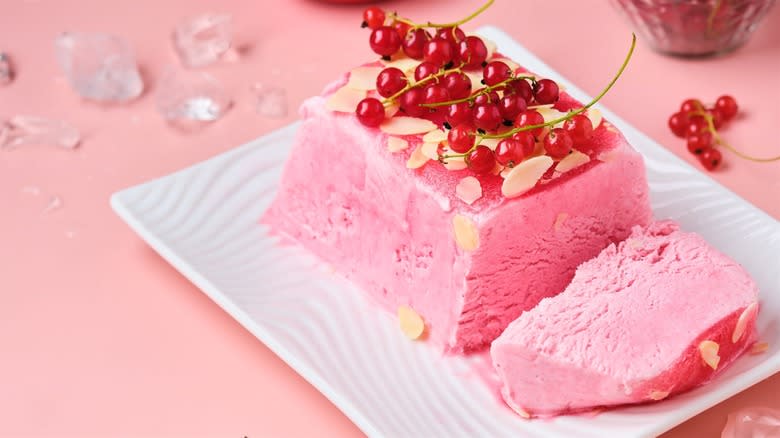
Apicius, a celebrated Roman gourmet, allegedly once said, "We eat first with our eyes." The "eating," of course, is done by the mouth, but our eyes pay attention to details that influence our expectations. Particularly, the shapes of food, its packaging and surroundings, and the tableware it's served on all prime our perception of their flavor. The bouba-kiki effect can be applied to the food world. It refers to a cognitive phenomenon where people associate the word "bouba" with round, soft shapes and "kiki" with sharp, angular ones.
Countless experiments across different countries have shown that most people associate round shapes with sweetness and creaminess, whereas bitter, salty, and sour tastes are attributed to angular forms. The latter is also true for carbonation, which is why you'll often see stars on beer and mineral water labels, for example. The former once almost cost Cadbury its reputation: when it rounded the edges of its chocolate bars, it caused an uproar. Surprisingly, the customers complained not about being sold less chocolate for the same price but about it tasting much sweeter than before. The formula hadn't changed -- the shape did. So, if you arrange food in a round shape, it might be perceived as sweeter. You can increase the effect by serving it on a round plate and contrasting it against other angular shapes.
Textures

The texture of food shapes our individual and cultural preferences and expectations, determines food's acceptability, and influences our perception of its flavor and hedonic ratings. Without texture, we'd be hard-pressed to identify foods -- in blind taste tests, less than 10% of participants could identify pureed cabbage or cucumber, for example. Over time, we build textural expectations, and if they aren't met, we often become disappointed and wary. If the texture is unfamiliar (like the slimy, sticky Japanese natto to a Westerner), doesn't feel right (such as stale popcorn or wilted lettuce), or poses a choking risk (like gummy, sticky, or stringy foods), we're wired to avoid it.
But what effect does it have on flavor? A 2015 study published in Neuropsychologia offered two amorphous foodstuffs (one smooth and one coarse) to its participants. Though both were otherwise identical and contained sour, bitter, and sweet notes, the latter was perceived as much more sour. Similarly, when comparing smooth and chunky tomato sauces made from the same ingredients, the mouthfeel and the act of chewing, or lack thereof, might affect your flavor experience. What's more, the texture of tableware or packaging also matters. For instance, cookies can seem chewier when dished out on rough plates, and wine tastes better if drank while caressing velvet at the same time.
Temperatures
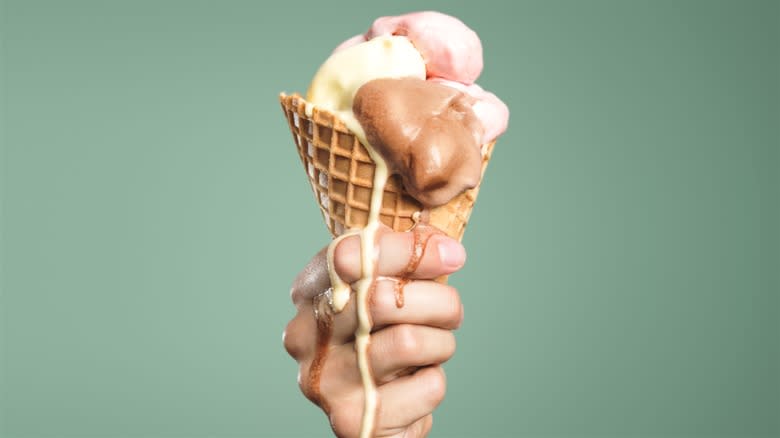
Have you ever wondered why melted ice cream tastes cloyingly sweet? Or why coffee tastes bad at room temperature? It happens because our perception of three out of five basic tastes -- bitter, sweet, and umami -- correlates with the temperature. Researchers believe that a designated TRPM5 protein is involved in our perception of thermal taste. Located in our tastebuds, it sends a more powerful signal to the brain when we ingest something at 60 to 95 degrees Fahrenheit. Anything outside this range and our tasting experience won't be optimal. For example, when you eat something straight out of the fridge, the flavors will be subdued. Similarly, serving tea or coffee hot (at 120 to 170 degrees Fahrenheit) leads to a decreased perception of bitterness –- we just can't register it as well. Curiously, the sour and salty tastes aren't affected by temperature, so you might feel them either way.
Besides the temperature of the food itself, how hot or cold your mouth is also matters, so watch what you drink with your meal, as it affects our tastebuds' ability to perceive those basic tastes. A piping hot coffee could downplay the sweetness of the donut, and iced water might make the salad greens feel less bitter. So, if you want to highlight them, go for a room-temperature beverage.
Tableware
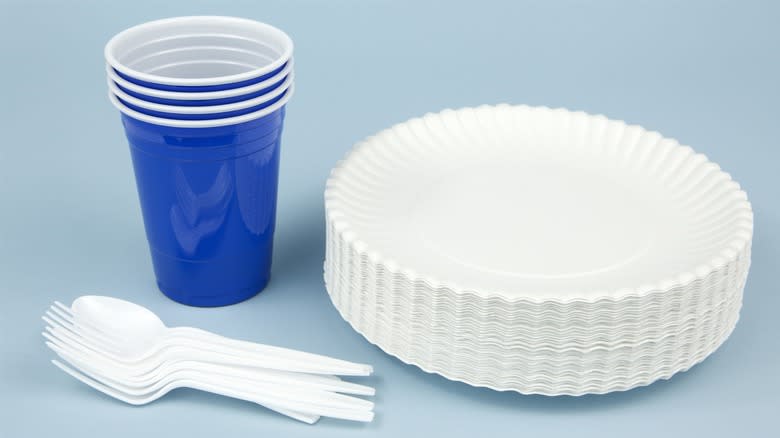
Plating tricks don't just add personality to your meals; they influence your perception of the food itself. Always pair the right plate color with the food you're serving. Research shows that a visual contrast can make the food more appealing. For instance, a berry mousse served on a white plate wasn't just appreciated more; it was perceived as sweeter and more flavorful compared to a black plate serving. The shape of the plate matters, too. Remember how we tend to associate circular shapes with sweetness? A rectangular plate could downplay the perceived sweetness of a dessert. Finally, an effect known as sensation transference is the reason why we enjoy a meal more if it's served in a heavier bowl-- we simply perceive it as containing more food.
What's more, your utensils could also be altering how your food tastes. For one, they can directly influence it — if your fork is made of copper or another reactive metal, it can release taste-altering ions when interacting with saliva, potentially increasing bitterness. But the material can also influence our perception -- compare the connotations of silver versus plastic spoons, for instance. Additionally, if the cutlery is heavy, it might trick us into thinking that the food is tastier and better plated.
Atmosphere

The food industry is at the forefront of the experience economy. In recent decades, the atmosphere that surrounds a product at the moment it is purchased or consumed has become integral to the total offering. It engages all of our senses, creating a superadditive effect. In other words, we're being sold a vibe. Think of your favorite restaurant. Is it just the food that you come back for, or does the atmosphere play a role? The décor, the lighting, the music, the furniture, the crowd -- they all influence our gastronomic choices and behaviors.
Research shows that the same food might taste different in varied environments. Our expectations are primed by the setting, and an appropriate one can make us believe the food tastes better or more authentic. For instance, blue cheese tastes more pungent in a farm-like setting, while whisky is more enjoyable in a woody environment. A combination of lights and music can highlight different flavors: red wine will taste fruitier in red light to a sweet-sounding song, for instance, and low-sugar orange juice will taste sweeter. Overall, the more we like the environment, the more we like the food, so if you're in the food business, it's time to enter the multisensory game.
Saliva
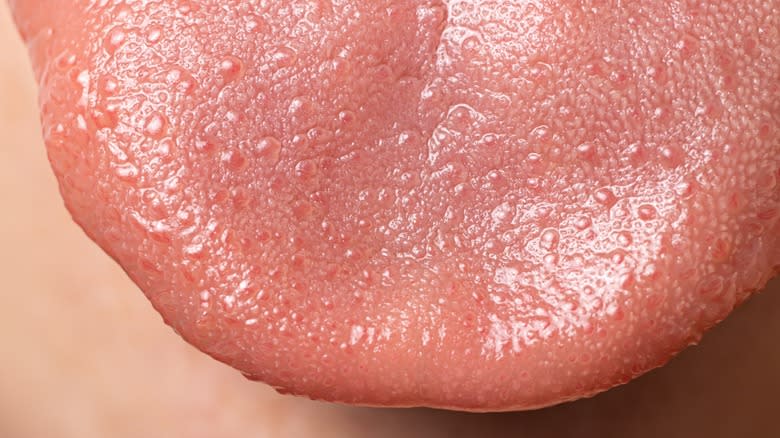
Saliva is usually taken for granted -- if noticed at all -- which is probably why it isn't studied as much as it should be. This underappreciated secretion actually plays a crucial part in our eating experience. We tend to think of taste buds as the vehicle delivering flavor sensations to the brain, but they would be rendered useless if it weren't for the lubricating powers of saliva. While not necessarily tasteless, it is neutral enough to serve as a medium that dissolves the chemical essence of taste into something our taste buds can recognize. Additionally, this blend of water, proteins, and enzymes serves as the catalyst for the intricate dance of digestion, breaking foods down in our mouths before they reach the stomach.
We all have slightly different compositions of saliva and produce different amounts of it. Curiously, those who salivate more tend to savor the food more intensely, likely due to increased swallowing and enhanced retronasal olfaction. What your saliva is made up of at any given moment depends on many factors, such as age, gender, and past experience. The protein content of saliva may change with repeated exposure to certain foods, making them more palatable, thus influencing our food preferences. Once again, the food stays the same, but our perception of it changes.
Genes

If there are foods you've tried and hated with passion, your DNA might be behind it. Do you have strong feelings about truffles? Blame it on their androstenone and your genetically predisposed ability to smell it, which most people don't have. Does cilantro taste like soap? You're probably sensitive to aldehydes, found in both the polarizing herb and the cleansing fluid. Not a fan of cruciferous vegetables, no matter how they're cooked? Maybe it's not them; it's you. If you recognize yourself in these examples, don't beat yourself up for being a picky eater -- you might be a supertaster. Essentially, you have more tastebuds, and your genetic makeup makes you experience flavors more intensely, particularly the bitter and sweet ones.
On the other side of the spectrum, less sensitive individuals can eat broccoli like nobody's business but may also overindulge in sugar simply because they taste it less. But while genes may dictate the foods we eat, they are not necessarily set in stone. Enter nutritional epigenetics -- an emerging area of scientific research that studies the impact of extrinsic factors on gene expression. It explores how specific nutrients and dietary patterns can influence epigenetic modifications, potentially affecting health outcomes and disease risk, and one day might change the way we eat and perceive flavors.
Read the original article on Tasting Table.

